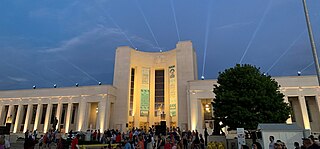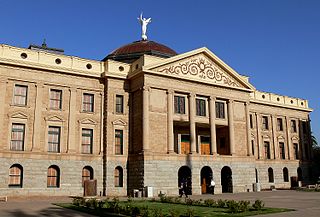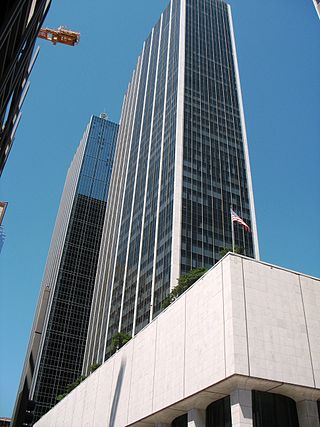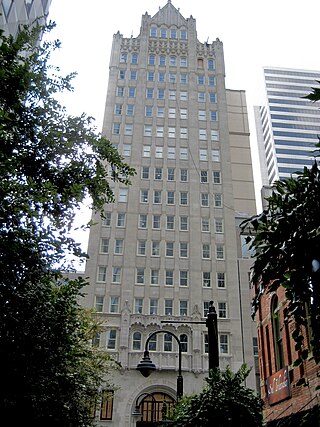
Ennis is a city in eastern Ellis County, Texas, United States. The population is 20,159 according to the 2020 census, with an estimated population of 21,210 in 2021. Ennis is home to the annual National Polka Festival.

Dealey Plaza is a city park in the West End Historic District of downtown Dallas, Texas. It is sometimes called the "birthplace of Dallas". It was also the location of the assassination of John F. Kennedy in 1963; 30 minutes after the shooting, Kennedy was pronounced dead at Parkland Memorial Hospital. The Dealey Plaza Historic District was named a National Historic Landmark on the 30th anniversary of the assassination, to preserve Dealey Plaza, street rights-of-way, and buildings and structures by the plaza visible from the assassination site, that have been identified as witness locations or as possible locations for the assassin.

Fair Park is a recreational and educational complex in Dallas, Texas, United States, located immediately east of downtown. The 277-acre (112 ha) area is registered as a Dallas Landmark and National Historic Landmark; many of the buildings were constructed for the Texas Centennial Exposition in 1936.

The Hall of State is a building in Dallas's Fair Park that commemorates the history of the U.S. state of Texas and is considered one of the best examples of Art Deco architecture in the state. It was designed and built for the Texas Centennial Exposition.

The Texas School Book Depository, now known as the Dallas County Administration Building, is a seven-floor building facing Dealey Plaza in Dallas, Texas. The building was Lee Harvey Oswald's vantage point during the assassination of United States President John F. Kennedy on November 22, 1963. The Warren Commission concluded that Oswald, an employee at the depository, shot and mortally wounded President Kennedy from a sixth floor window on the building's southeastern corner; Kennedy died at Parkland Memorial Hospital.

The Texas Theatre is a movie theater and Dallas landmark located in the Oak Cliff neighborhood of Dallas, Texas. It gained historical significance on November 22, 1963, as the location of Lee Harvey Oswald's arrest over the suspicion he was the killer of Dallas Police Officer J. D. Tippit. Today, it hosts a mix of repertory cinema and special events.

William Hardin Adamson High School, formerly Oak Cliff High School, is a public secondary school located in the Oak Cliff area of Dallas, Texas, United States. It is part of the Dallas Independent School District and is classified as a 5A school by the UIL. In 2015, the school was rated "Met Standard" by the Texas Education Agency.

The Munger Place Historic District is a neighborhood and historic district in Old East Dallas, Texas (USA), generally lying between North Fitzhugh Avenue on the southwest, Gaston Avenue on the northwest, Henderson Avenue on the northeast, and Columbia Avenue on the southeast. Detailed boundaries are defined in the Munger Place Ordinance. It is a Dallas Landmark District and listed on the National Register of Historic Places.

The Swiss Avenue Historic District is a residential neighborhood in East Dallas, Dallas, Texas (USA). It consists of installations of the Munger Place addition, one of East Dallas' early subdivisions. The Swiss Avenue Historic District is a historic district of the city of Dallas, Texas. The boundaries of the district comprise both sides of Swiss Avenue from Fitzhugh Street, to just north of La Vista, and includes portions of Bryan Parkway. The District includes the 6100-6200 blocks of La Vista Drive, the west side of the 5500 block of Bryan Parkway the 6100-6300 blocks of Bryan Parkway, the east side of the 5200-5300 block of Live Oak Street, and the 4900-6100 blocks of Swiss Avenue. The entire street of Swiss Avenue is not included within the bounds of the Swiss Avenue Historic District. Portions of the street run through Dallas' Peaks Suburban Addition neighborhood and Peak's Suburban Addition Historic District. 5215 Swiss was built in 1914 and was the home of J. P. Cranfield

The Wilson Building is an historic 8-story building in the Main Street district of downtown Dallas, Texas. The building was completed in 1904 and patterned after the Palais Garnier in Paris, France. The historic structure fronts Main Street on the south, Ervay Street on the east, and Elm Street on the north. The Wilson building was the tallest structure in Dallas from 1904–1909 and was considered the premier commercial structure west of the Mississippi. The Wilson Building is situated across from the flagship Neiman Marcus Building and is adjacent to the Mercantile National Bank Building.

James Riely Gordon was an architect who practiced in San Antonio until 1902 and then in New York City, where he gained national recognition. J. Riely Gordon is best known for his landmark county courthouses, in particular those in Texas. Working during the state's "Golden Age" (1883–1898) of courthouse construction, Gordon saw 18 of his designs erected from 1885 to 1901; today, 12 remain.

First Presbyterian Church of Dallas is a historic congregation at 1835 Young Street in the Farmers Market District of downtown Dallas, Texas (USA). The current building is a contributing property in the Harwood Street Historic District and a Dallas Landmark. The congregation was founded in 1856 as the first U.S. (Southern) Presbyterian Church organized in Dallas, and is the mother church from which many other Presbyterian churches in the area have stemmed.

The National is a 52-story, 191 m (627 ft) skyscraper in the Main Street district of downtown Dallas, Texas, adjacent to the Dallas Area Rapid Transit (DART) Akard Station. It is the tenth tallest building in the city. In January 2010 the building was closed due to low occupancy rates. It was listed on the National Register of Historic Places in 2017.

The Joule Hotel is a four-star, 160-room hotel developed by Headington Hotels, owned by Timothy Headington. Located at 1530 Main Street, between Akard Street and Ervay Street, the building was constructed in 1927 as the Dallas National Bank Building, and was known later as the SPG Building. At the end of Stone Street Plaza, it is in the Main Street District of downtown Dallas, Texas, and with the Kirby Building, one of two Gothic high-rises in the city.

The Statler Hotel & Residences is a hotel of mid-twentieth century design located at 1914 Commerce Street in downtown Dallas, Texas (USA). It is located on the edge of the Farmers Market District and adjacent to Main Street Garden Park. The hotel opened in 1956 as The Statler Hilton and was praised as the first modern American hotel and was designed by William B. Tabler. Later renamed the Dallas Grand Hotel, it closed in 2001, then was restored and reopened in 2017. It is currently a member of Historic Hotels of America, the official program of the National Trust for Historic Preservation.

The Majestic Theatre is a performing arts theater in the City Center District of Downtown Dallas. It is the last remnant of Theater Row, the city's historic entertainment center on Elm Street, and is a contributing property in the Harwood Street Historic District. The structure is a Dallas Landmark and is listed on the National Register of Historic Places.

The Dallas Municipal Building is a Dallas Landmark located along S. Harwood Street between Main and Commerce Street in the Main Street District of downtown Dallas, Texas that served as the city's fourth City Hall. The structure is also a Recorded Texas Historic Landmark and a contributing property in the Harwood Street Historic District, located across the street from Main Street Garden Park.

Dallas High School was a public secondary school in Dallas, Texas. It is the alma mater of several notable Americans, including former U.S. Attorney General and Supreme Court Justice Tom C. Clark. Built in 1907, the 3.5-story classical revival structure is located in the downtown City Center District next to the Pearl/Arts District DART light rail station.
Throughout Dallas–Fort Worth, there is a large lesbian, gay, bisexual, and transgender community. Since 2005, DFW has constituted one of the largest LGBT communities in Texas.

The Tenth Street Freedman's Town is a historic African American community in the Oak Cliff section of Dallas, Texas. A freedmen's town is a community settled by former slaves who were emancipated during and after the American Civil War. The freedmen's town that became known as Tenth Street began near the confluence of Cedar Creek and Cedar Creek Branch, at the foot of an African American burial ground dating back to 1846. The name "Tenth Street" became associated with the community in 1887, when John Scarborough Armstrong and Thomas Lafayette Marsalis platted the town of Oak Cliff.



























